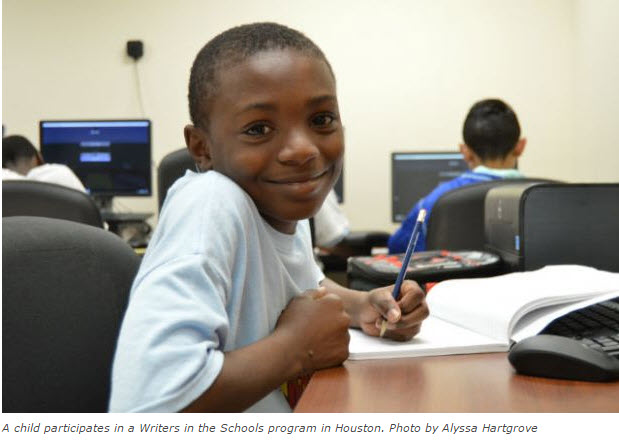
Every video game is actually a story. We don’t necessarily think of it that way, but as a player of a game, we are a character. As characters in that story, we meet obstacle after obstacle and conflict after conflict. We have to solve problems. That’s how you level up or create things depending on the video game that you’re playing. The structure of a story and the structure of a game are pretty much exactly the same.
By Rebecca Sutton
Writer/Editor, National Endowment for the Arts
(CC BY 3.0) arts.gov
In many ways, “screen time” has become the scourge of modern parenting. At what age should children be given digital devices? How many hours a day should they use them? Is it safe for their brains? For their eyes? For their social development?
But Houston nonprofit Writers in the Schools (WITS) is changing the dynamic, and turning screen time into a source of learning and creativity. This morning, we announced that WITS will receive one of 37 inaugural Art Works: Creativity Connects grants for their nascent WITS Digital program. These 37 grants—totaling $2,500,000—were designed to support partnerships between arts and non-arts organizations as a way to better integrate creativity throughout all social sectors. These grants were part of this morning’s larger funding announcement, which included over $30 million for Art Works and Challenge America awards and Creative Writing Fellowships.
Since its establishment in 1983, WITS has sent professional writers into schools to teach reading and writing by emphasizing the imagination. For WITS Digital, students instead tell their stories using video games they design through the platform Gamestar Mechanic. Although the tools have changed from pencil and paper to video games, WITS Executive Director Robin Reagler said the leap isn’t as great as it might first appear.
“Every video game is actually a story,” said Reagler. “We don’t necessarily think of it that way, but as a player of a game, we are a character. As characters in that story, we meet obstacle after obstacle and conflict after conflict. We have to solve problems. That’s how you level up or create things depending on the video game that you’re playing. The structure of a story and the structure of a game are pretty much exactly the same.”
Reagler hopes this different storytelling platform will engage students whose imaginations are better sparked by the music and imagery of a video game than by simple text. “We try and go to where children are,” said Reagler. “We want to be in the place where they are most alive, most excited. Video games are one place where even some of our most reluctant or frustrated writers get excited.”
This enthusiasm can be seen in the types of games students are creating. One student turned his experience crashing his bike into a dumpster into a game featuring the evil Dumpstertron that players had to thwart. Another student created a game based on her grandmother’s death, and her family’s subsequent trip to Mexico to celebrate her life. There was also a game titledWatch Your Back, which charted a student’s journey with scoliosis through various levels that dealt with blood tests, x-rays, and doctor’s appointments. With the support of the NEA grant, WITS and project partners E-Line Media and Histrionix Learning Company are working to imbue Gamestar Mechanic with even greater opportunity for self-expression. This might include new ways to personalize characters, or expanded options for inserting plot and dialogue.
One of the biggest surprises Reagler has found with WITS Digital is the level of collaboration. In a typical creative writing setting, students write alone and share their work at the end of class. “With WITS Digital classrooms, the sharing is continuous,” said Reagler. “They are constantly jumping up and looking over each other’s shoulders, or ‘Come over here, would you look at this, I’m not sure how this works.’ The desire to work together and help each other make their games as amazing as possible is so strong.” When the program first launched, Reagler said she had envisioned a stereotypical gamer working alone, much as writers do. “It turned out we found the opposite to be true,” she said. “The kids really wanted to be able to connect through these games.”
She thinks this collaborative element has also pushed students to develop stronger stories. As is the case with books, Reagler said a strong storyline can be the difference between a fine game and a great game. Designing a game that their peers are excited to play has pushed students to create more engaging, powerful stories, a talent which Reagler hopes will eventually translate to writing.
In many ways, even sharing work with families has become more collaborative than traditional writing might allow. At the end of every WITS Digital program, parents and students are invited to a “Game Jam Story Slam,” where multiple computers are organized in one space so families and other students can play the newly designed games. “It’s just so fun to see,” said Reagler. “They put their parents down in the chair in front of the computer, and they’re helping them and explaining it to them. It turns the tables so that the children are the ones who are in the know. That’s exactly what you want education to be.”
Yet it is another type of table-turning that Reagler considers to be perhaps the most important outcome of WITS Digital: transforming children from passive consumers of media into creators. “It’s not simply empowering, it’s revolutionary,” she said. “They learn what goes into any segment of media, and they learn it by doing it. They look at the games that they play differently. They look at television differently. They look at these things as a maker, as a creator.”
